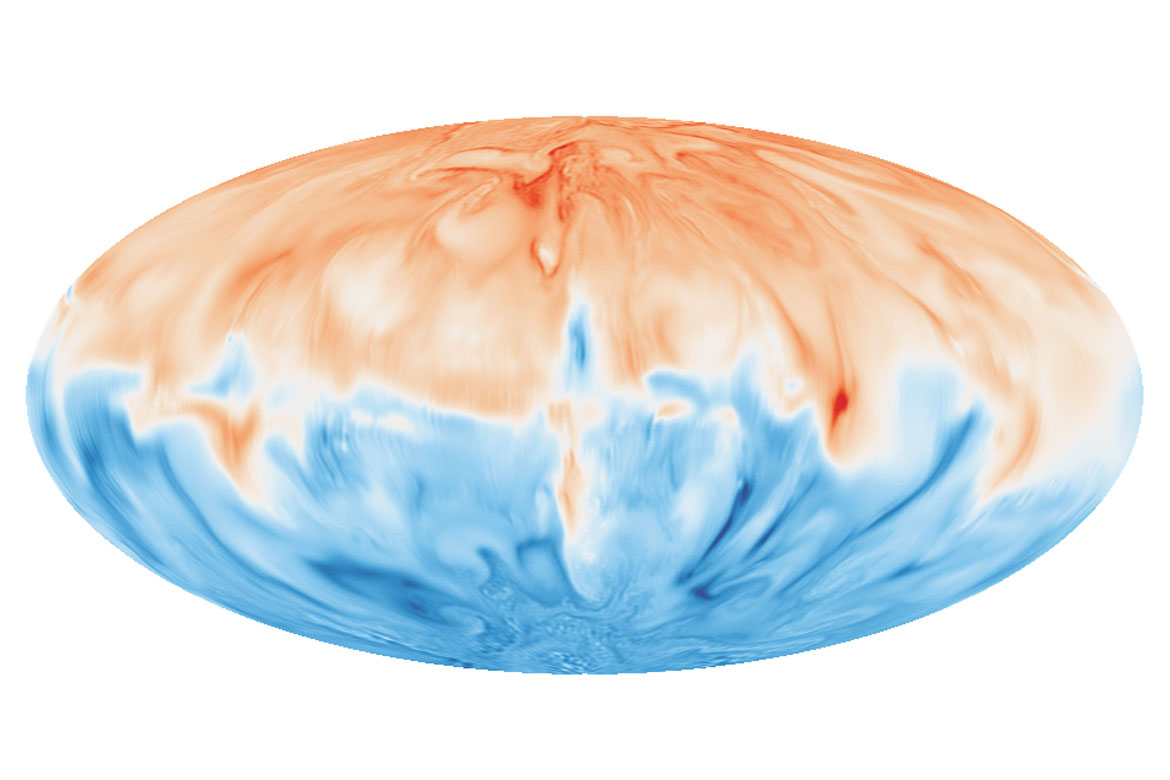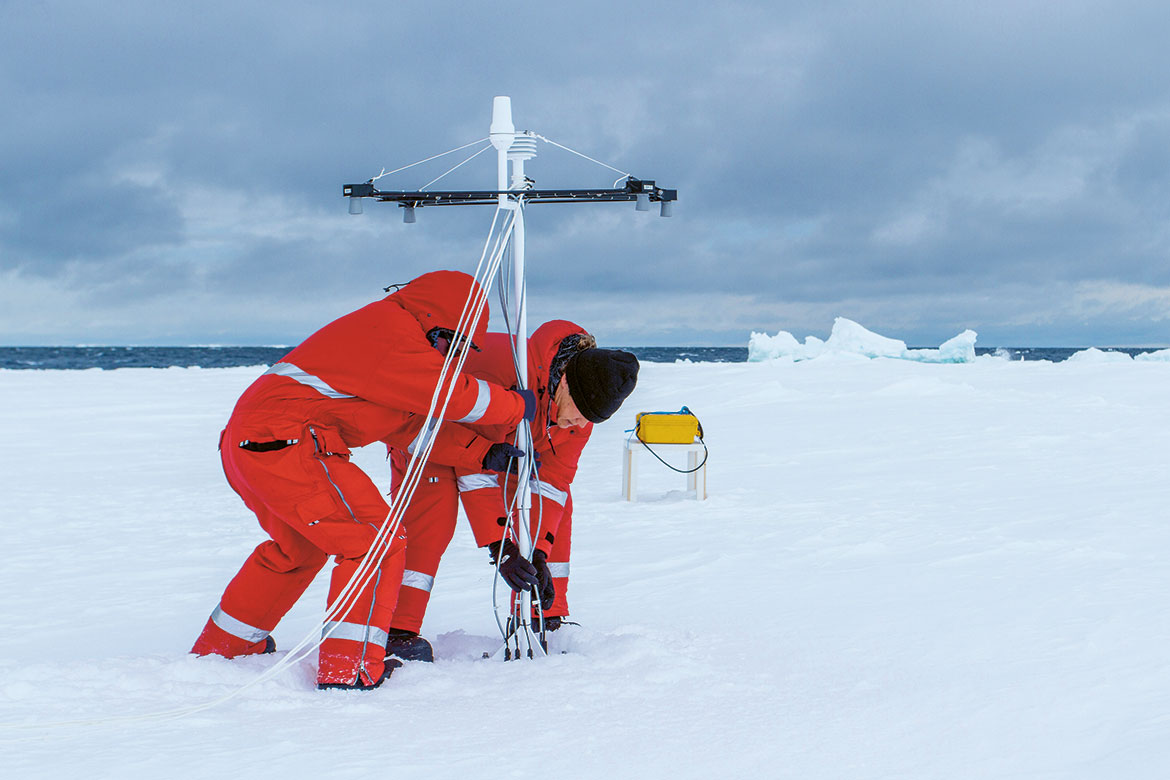No model for the Earth’s magnetic field
Scientists have yet to answer all our questions about the Earth’s magnetic field and its fluctuations. But satellites and supercomputers are helping them to produce more realistic models.

Everything is in flux: The magnetic field at the surface of the Earth’s core, at a depth of some 3,000 km from its surface, according to a new model produced at ETH Zurich. | Image: Andrey Sheyko: ETH Zurich, Institute for Geophysics
We feel nothing, and yet far beneath our feet, mysterious things are happening. Giant oceans of liquid metal, 2,000 kilometres in depth, are turning around the solid iron core of the Earth. Mighty vortices rage in these boiling metal seas. In the zones near to the solid core, burning rivers of metal flow up towards the Earth’s mantle, where they cool down and then sink back into the seething seas. Because this hot liquid is conductive – presumably comprising mostly iron with ten percent nickel – it creates a magnetic field when it moves. Researchers call this phenomenon the geodynamo, and it is primarily responsible for the Earth’s magnetic field.
But scientists still do not precisely understand how the magnetic field of the Earth is generated. Even the Earth’s interior, with its solid inner core and liquid outer core, is only known to researchers indirectly, by measuring seismic waves. What’s more, the Earth is extremely turbulent inside. The Earth’s axis turns, but the Earth itself turns on its axis, which leads to complex turbulence. Every day, waves flow through the liquid outer core.
Unrealistic assumptions
These conditions are so complex that researchers have to make unrealistic assumptions in order to reach rational results. For example, they work with altered natural constants or highly adjusted values for the viscosity of liquid iron. “Most researchers assume that the electrical conductivity in the outer core is greater than it ought to be because that helps them to create a magnetic field”, says Andrew Jackson of ETH Zurich.
Jackson’s team of researchers have now published a model of the Earth’s magnetic field in ‘Scientific Reports’ of the specialist journal Nature. It’s a model that probably gets closer than ever before to the real state of things. The Earth’s interior is depicted here as a spherical grid. At each point in the grid, the researchers use numerical methods to calculate their equations – and they do so step by step for tiny time periods. “Modelling the Earth’s magnetic field is one of the most difficult problems in geophysics”, says Jackson. So it is all the more astonishing that his model meanwhile describes a pretty realistic scenario. A conductive, non-compressible liquid is enclosed in a rotating spherical shell. The energy that drives this flow of warmth comes from an inner core that grows extremely slowly and from the radioactive decay of instable isotopes in the hot liquid. Jackson is convinced that his model is correct, even though it still contains slightly incorrect notions of the actual inner structure of the Earth. We still don’t even understand the heat transfer from the Earth’s core to the Earth’s mantle.
This progress has been made possible in the past decade primarily by the emergence of supercomputers. The simulations made by the ETH researchers have been carried out at the Swiss National Supercomputing Centre (CSCS) in Lugano. “The high-performance computers at CSCS have put us at the forefront of science internationally”, says Jackson. But even the newest models still cannot encompass the complexity of the whole magnetic field of the Earth. The geodynamo generates up to 95 percent of the magnetic field, but there are other influential factors. A few percent come from magnetised rock in the Earth’s crust. Even the tides of the oceans contribute a twenty-thousandth to the strength of the field. This is due to sodium and chloride ions flowing back and forth in the salt water and thereby establishing their own a magnetic field.
Solar storms squeeze the magnetic field
Recently, an aspect has come into focus that as a rule contributes only a little to the magnetic field – namely some 0.1 percent. It’s the ionosphere, which lies between 80 and 1,000 kilometres above the Earth. Numerous GPS and communications satellites are found in this layer of the atmosphere, as is the International Space Station ISS. It’s there that human beings can truly experience the importance of the protective magnetic ‘membrane’ around the Earth. Because when solar magnetic storms are raging, the Earth’s magnetic field contracts. Satellites then orbit at times in an unprotected space. Solar wind (a flow of highly energetic particles) can damage the sensitive measuring instruments in these satellites, some of which can break down altogether. Such magnetic storms also intensify the electric currents in the ionosphere, causing a local strengthening of the magnetic field. “There are times when the ionosphere can contribute up to one percent of the Earth’s magnetic field”, says Claudia Stolle, a professor of geomagnetism at the GFZ (German Research Centre for Geosciences) in Potsdam. Its impact can even be felt on Earth, for example when solar storms disrupt the electrical grid leading to blackouts.
“Magnetic storms can result in inaccuracies of up to ten metres in GPS location signals”, says Stolle. “We’ll have to step up our understanding of geomagnetic disturbances in the ionosphere if we want to create an early warning system – a kind of weather forecast for space”.
Measurements by satellite
In order to obtain a more detailed picture, the European Space Agency began its Swarm mission in 2013. Three satellites now orbit the Earth – two of them at a height of 462 km, the third at 511 km. They measure the strength and direction of the magnetic field, the electrical fields and the plasma density in the protective magnetosphere. And they do so to the incredible accuracy of less than one nanotesla, i.e., 0.001 microteslas. For comparison: the average for the Earth’s magnetic field is some 50 microteslas. This data being collected should help us understand the migration of the magnetic poles and their imminent reversal.
The Swarm data prove that the Earth’s magnetic field is decreasing a lot at present around the South Atlantic, where it measures just 20 microteslas compared to 60 microteslas at the Poles. “We would like to understand why the field is weakening so quickly”. Anomalies in the magnetic field are quite possibly a sign that the Earth’s magnetic field is about to reverse. This has happened repeatedly throughout the history of the Earth. The last reversal of the Poles happened as long as 780,000 years ago. “We still don’t understand the reversal of the Poles”, says Jackson. “Because the timeframe is so vast and our models are far removed from the geophysical system, it’s very difficult”. Two years ago, Jackson presented a mechanism that was successful in depicting the Earth’s magnetic field and the reversal of its poles, though it probably doesn’t exactly reproduce the actual state of things.
The data from Swarm are also helping the researchers to improve their models, step by step. Their measurements provide information on the electrical conductivity of the Earth’s mantle – in other words, the top layer that extends downwards for 3,000 kilometres. These data can be extrapolated from the overall field, which in turn allows for a refinement of the models for the geodynamo in the Earth’s interior. In general, the Swarm data have made quite a stir among researchers, and have helped to bring together different disciplines that have previously been focused on individual phenomena. Perhaps they might even manage to agree on a common approach at some point in the future. “There still isn’t any overall model for our Earth’s magnetic field”, says Stolle.
Hubert Filser works regularly for the Süddeutsche Zeitung and for the TV programme Quarks & Co. He studied physics and lives in Munich.




